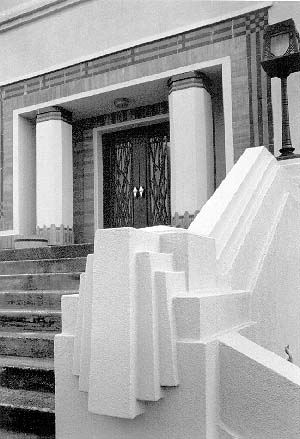Benoît Grimbert
A406 North Circular Road
École nationale supérieure d’architecture de Paris Malaquais
1 rue Jacques Callot, Paris
Nov 10 – Nov 29, 2008
A couple of hundred yards down a road on the Left Bank, lined with galleries and antique shops, we came to the North Circular Road.
Not of course the actual North Circular, which runs from Kew Bridge to the Woolwich Ferry through suburban London, but a Mois de la Photo show by Benoît Grimbert at l‘Ecole Nationale Supérieure d’Architecture Paris-Malaquais.
You can see a slightly extended version of the 20 pictures on show there on his web site.
Benoit Grimbert (b1969) lives in Paris but travelled to London on several occasions to take a series of pictures along the length of the A406 North Circular Road. Unlike London’s South Circular which is almost entirely conceptual, the North Circular has a physical existence – and I’ve walked along most of its accessible parts (there are some elevated motorway style sections where I think pedestrians are not encouraged and possibly prohibited.)
So I was not just looking at a show of photographs, but a set of photographs of something I also know from my own photographs, several of which could be cropped to give virtually identical views.
If I went back to take pictures of the A406, I would work with a panoramic camera (and I have taken some pictures of it with one) as more suited to the idea of flow of traffic. Grimbert works to a square format and seems to be very much a man wedded to his tripod and spirit levelt, all restrictions that I think oppose the central concept of the work being about movement, traffic and flow. It ends up being very much a static view, one that concerns itself largely with the structures of various types which surround the road rather than the road itself or the kind of concepts which, according the text, it is concerned with.
The mismatch between technique and concept doesn’t in one sense particularly concern me. This is after all a show of photographs and it isn’t unusual (certainly in these days) for perfectly good pictures to be accompanied by a completely irrelevant sheet of academic jargon. But here I think the work was sometimes indecisively trapped between the visual and the conceptual (and the text from the show would certainly be a candidate for Pseuds Corner, except that I think that would be a concept the French may be unable to appreciate.)
Perhaps the problem I have with his work is that I know the North Circular. The following day I came across some of his pictures of Normandy – which you can also see on his web site – in a projection at the École nationale supérieure d’architecture de Paris La Villette. I found those more interesting than the A406, but perhaps if I was from Normandy I would have my reservations?
Actually I think not. I’ve cycled around Normandy and do know it at least slightly – and the same is true of another of the projects on his web site, Lisieux. Here the work is essentially about structures and their relationships to each other and his chosen techniques fit well with the subject and Grimbert’s intentions.
Grimbert presumably works with a medium format camera using 120 film and the prints are clear and detailed, though not especially so. (He claims that his colour prints are “tirage manuels argentiques” but there was no sign of the lack of bleach-fixing that this appears to suggest – perhaps the French doesn’t mean what it appears to – these seemed to me to be perfectly normal colour coupler prints.)
Peter Marshall Here are a few assorted digital images I’ve taken in the past couple of years on the North Circular – taken as parts of different projects. One day I’ll get around to developing and scanning the panoramic images that I also made on some of these visits!

Late evening in winter at Ilford.
There is a picture by Grimbert from almost exactly this point, but in rather different lighting.

River Roding and North Circular, Redbridge

River Roding and North Circular, Barking

Ace Cafe, the most famous site on the old North Circular, Stonebridge Park

North Circular at Barking, looking South










